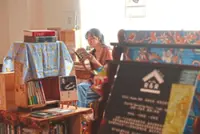Many of the young people from the village have moved away, but still retain a strong connection to the area. — Photos: ZHAFARAN NASIB/ The Star
AFTER more than 60 years, a significant era is drawing to a close in the quiet coastal community of Weld Quay in George Town, Penang.
Around 200 families, many of whom have lived there their entire lives, are preparing to leave their homes to make way for future development.
Known locally in Hokkien as Sin Hai Kee Thun Tay (the Weld Quay reclamation area), the village has been home predominantly to Chinese families, with some households spanning four generations under a single roof.
Its narrow lanes and tightly packed houses, situated at the end of Lebuhraya Merdeka, have stood for decades as a testament to community spirit and endurance. Some dwellings still stand on stilts above the water.
Pengkalan Weld Village Community and Management Council (MPKK) chairman Loo Soo Lee said the land was once merely a muddy stretch of coastline before families began arriving.
They initially rented rooms inland before moving to the area and building their own houses, forming the basis of a close-knit community in the 1960s.
“In the beginning, there was no running water or electricity. Residents had to walk some distance to fetch water from the village entrance.
“It was not until the tenure of the late Tun Dr Lim Chong Eu as chief minister in the 1970s that essential utilities were finally introduced.
“This marked a turning point in the village’s history, transforming it from a makeshift settlement into a vibrant neighbourhood,” Loo said.
She added that residents were granted temporary occupancy licences (TOL) and paid annual taxes to the authorities, typically between RM100 and RM150.
Loo, now 58, moved to the village at 19 after her marriage.
She said many younger residents had since moved away, some for employment and others for further education.
However, despite establishing lives elsewhere, the village remains dear to them.
“Many still return during festive periods, particularly Chinese New Year, to reunite with their families.
“The lanes fill with laughter and conversation. The aromas of home-cooked meals wafts through the air.
“For a short while, it feels like the old days once more and time seems to stand still,” she said.
A flourishing past
The Sin Hai Kee Thun Tay settlement once supported a thriving internal business ecosystem.
In the past, several charcoal factories were located at the rear of the village, providing stable employment for the residents.
However, these factories have long since ceased operation, leaving only memories of a busy industrious past.
In the heart of the village, a modest sundry shop continues to meet the daily needs of this close community.
The shop, which also serves as a local coffee spot, has become a gathering place where long-time residents linger over a cup of coffee, sharing stories and recalling past events.
Its owner, Phuah Eng Teck, 73, said his father opened the shop about 50 years ago.
The wooden shop has become a cornerstone of daily life in the village.
“We used to stock all sorts of necessities – rice, cooking oil, sugar, biscuits, tinned food, and detergent.
“Whenever someone needed something, they didn’t have to travel far. They could simply come here, and we would usually have it,” said Phuah, who is assisted by his wife, Lee Bee Im, 71.
Another long-term resident is sugarcane juice seller Chuah Gee Cheng, 60, who has lived in the village since his childhood.
He remembers his grandfather first building their house on a small plot of land there.
“Although modern buildings have sprung up all around us, life within the village still feels much like it did in the old days.
“It was truly special growing up here, where everyone knew each other.
“The sense of community we have is something difficult to find in other neighbourhoods,” said Chuah.
Enduring connections
The village’s residents association chairman Yeoh Siew Beng, 70, said that despite some initial hesitation among residents, the majority understood that their occupation of the land was always considered temporary.
“They knew the day would come when they would have to move out, when the authorities require the land for development,” he said.
“For those whose homes are damaged or infested with termites, they are relieved to be compensated with a new house.
“However, for families living in larger homes, often multi-generational households accommodating two or more families, there are concerns about the size of the new units.
“They worry that the new homes may not be large enough for everyone,” he elaborated.
Despite these concerns, Yeoh remains optimistic.
“The good news is that most residents will still see each other after moving to the new place in Cecil Residensi.
“Hopefully, the strong community bonds will not be broken by the relocation,” he said.
New horizons
Pengkalan Kota assemblyman Wong Yuee Harng said residents were expected to be relocated by the end of the year.
He said about 80% of the residents holding a TOL would be offered a direct house exchange, ensuring they would have a place to live.
“For those without a TOL, each case will be assessed individually. We will assist them through the process,” he said.
Wong noted that the relocation was currently awaiting the issuance of resettlement notices and offer letters from both the district office and Penang Development Corporation (PDC).
Residents would be relocated to Cecil Residensi, a new affordable housing project in George Town developed by PDC, offering a new chapter for the long-time residents.
Meanwhile, Penang Heritage Trust (PHT) president Clement Liang said that while the quaint neighbourhood on reclaimed land was not part of the clan jetties along Weld Quay, the forthcoming development should consider the sensitivity of the area.
“The land is situated at the boundary of the George Town Unesco World Heritage Site, and we hope there will be no high-rise developments that spoil the heritage landscape.
“I hope proper consultation and study will be conducted before any major projects are undertaken,” he urged.
Nevertheless, Liang acknowledged that the relocation to new housing could provide residents with much-needed improvements in their living conditions.
He pointed out that the old wooden houses, closely packed together, not only presented significant fire risks but were also difficult and expensive to maintain.
“The new homes will offer a fresh start for the residents.
“The change brings with it a safer and more sustainable living environment for the long-time residents,” he concluded.










